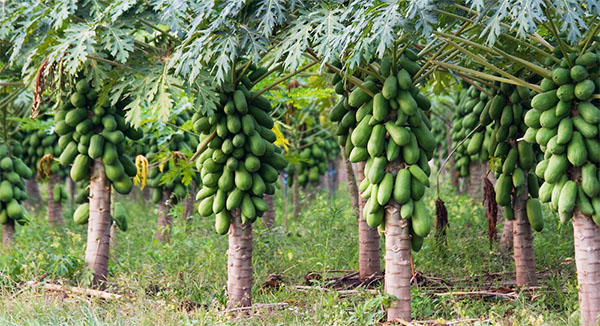USES
Papayas contain an enzyme called papain that aids digestion; in fact, it can be used as a meat tenderizer. Papaya is also high in fiber and water content, both of which help to prevent constipation and promote regularity and a healthy digestive tract
Papaya consuming the antioxidant beta-carotene, found in papayas, may reduce cancer risk.
CULTIVATION
Papaya is basically a tropical plant however is also grows well in sub- tropical parts.
Those feet hills which taken a mild winter are ideal for papaya cultivation low temperature and frost limit. Cultivation in higher altitudes. It can be a grown from the sea level to an altitude of 100 meters but above an altitude of 600 meters.
Popularly known as 'MadhuBindu' and is cultivated for table as well as processing purpose. The variety bears greenish-yellow oblong-shaped fruits with orange thick flesh and good flavor. The variety can be maintained pure by growing in isolation. Due to its excellent fruit quality it fetches good market value.
SPECIES
Papaya grows well on many types of soil, but they must be adequately drained. Restricted soil drainage promotes root diseases. Most commercial production in Hawaii is on porous as lava. Production on other soil types is limited to low rainfall areas where restricted drainage is less likely to cause problems. Heavy clay and pahoehoe lava soils should be avoided. Soil pH near neutral (pH 6.0 to 7.0) is preferred.
MARKETING
India is world’s largest producer of this fruit. The largest Papaya producing states include Andhra Pradesh, Gujarat, Karnataka, West Bengal, and Madhya Pradesh & Maharashtra. Three notable varieties of Papaya in India include Pusa Delicious, Pusa Dwarf and Pusa Nanha. . Our company also provides the facility of Buy Back agreement.
HARVESTING
Papaya plants tend to over bear. Fruits are so crowded that they do not get proper space for development. Fruit thinning should be done to get well sized fruits. Proper size is attained in 10 months of flowering. Near ripening fruits change colour from green to yellowish green. Fruits should be harvested at maturity.
